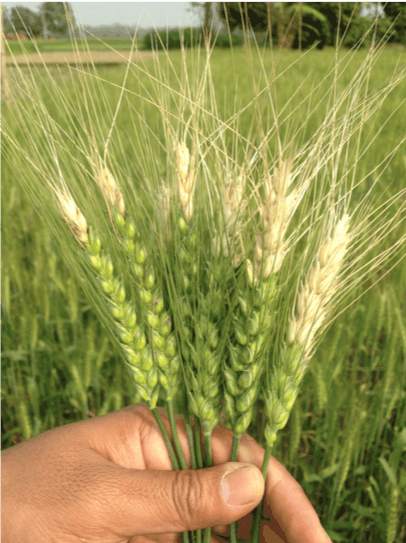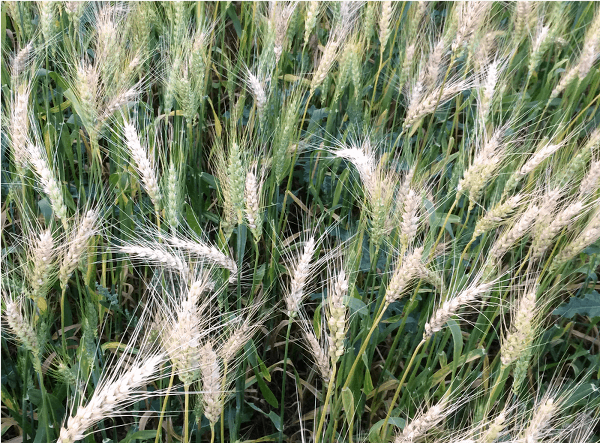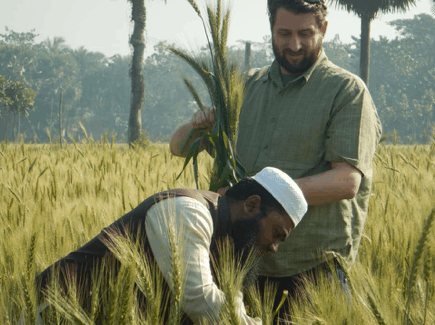Cross-continental disease and crop modeling collaborations to beat back wheat blast
Cross-continental collaborations facilitated by the CGIAR Platform for Big Data in Agriculture thrive to beat back the threat of wheat blast in Brazil and Bangladesh.
Because the disease is new, knowledge of wheat blast epidemiology and modeling was limited in Bangladesh. That’s why scientists at the International Maize and Wheat Improvement Center (CIMMYT) reached out to Professor Jose Mauricio Fernandes, a Crop Pathologist, and Mr. Felipe de Vargas, a Computer Scientist, within the Universidade de Passo Fundo (UPF) in Brazil, who had already been working on weather-forecast based blast modeling. The pair began collaborations with CIMMYT’s Timothy J. Krupnik, Senior Scientist and Systems Agronomist to validate blast forecasting models and transfer them to Bangladesh as part of the USAID supported Climate Services for Resilient Development (CSRD) project.

This problem is now being solved with resources from the CGIAR’s Platform for Big Data in Agriculture. Speaking about “Combining crop and disease modeling with numerical weather forecasting to inform wheat blast early warning systems in Bangladesh, Brazil and beyond”, a new project supported by the Community of Practice on Crop Modeling from the Big Data Platform, Professor Fernandes explained that,
“We are developing a model for an early warning system that considers seasonality and wheat growth, which explores the date of sowing for disease management practice as well as climate suitability for wheat blast in unaffected areas.”
To achieve this aim, the team is integrating the widely-validated Decision Support System for Technology Transfer (DSSAT) model into the wheat blast early warning system driven by weather forecasts and equations that consider blast ecology and development. Dr. Fernandes explained that
“DSSAT is a general model for simulating crop growth and development, as well as the soil and plant water, nitrogen, phosphorus, and carbon dynamics. DSSAT comprises a suite of crop simulation models, including the ‘NWheat’, an additional wheat model added to the current wheat models on the platform.
He continued,
“…currently, DSSAT-NWheat is under improvement to account for damage imposed by diseases and pests. A generic disease simulator was parameterized to mimic wheat blast inoculum build up and consequent colonization of wheat spikes. Upon spread of fungal mycelia, wheat grain development will reduce as a function of wheat blast intensity. The weather-based wheat blast simulator requires hourly observations of temperature, relative humidity, rainfall, and solar radiation. The novel wheat model (DSSAT-NWheat) can predict yield in the presence or absence of wheat blast. The new DSSAT-NWheat model is under validation in both countries.”
The research team is also using the models and completed wheat growth trials to explore historical data and model the historical risk of wheat blast infection.
“With DSSAT-NWheat as part of our modeling platform, we can explore the impact of sowing dates on the timing wheat spike formation and the risk of infection. We are now working to run a large number of virtual experiments with the modeling platform to adjust advisories for sowing date to avoid infection risks in both Brazil and Bangladesh” explained Krupnik.
“This effort to integrate crop with disease and numerical weather forecasting models shows the value-addition to a strong cross-continental science for development collaboration that comes from the Big Data Platform’s mini-grant to support our work.” Explained Dr. Krupnik. Dr. Fernandes added, “The partnership shows the importance of collaborative research, independent of the intercontinental distances that separate Brazil and Bangladesh. The results from the collaborative research will certainly have an impact on the wheat production of both the countries.”

The CGIAR Platform for Big Data in Agriculture supports cross-continental collaborations to beat back the threat of wheat blast in Brazil and Bangladesh. To the left, Mr. Felipe de Vargas and Jose Mauricio Fernandes of the University of Passo Fundo in Brazil work to calibrate the DSSAT-Nwheat model and integrate it with numerical weather forecasting and disease development models to warn farmers in advance of wheat blast disease risks. To the right, Zakaria Hasan and Timothy J. Krupnik inspect wheat in Bangladesh as part of efforts to validate the models.
January 16, 2019
Sultana Jahan and M. Shahidul Haque K
Latest news






